Volume 39, Number 2
Fall 2014
By David K. Richter, Esq.
Introduction
“The United States is a superpower with a third-world transmission grid.”[1] That was the critical but, for the most part, accurate evaluation provided by then Secretary of Energy Bill Richardson in 2003 after the August 14, 2003 blackout left more than 50 million people across eight states and Ontario without power for several hours. More than a decade after the Northeast blackout cost the U.S. and Canadian economies approximately $6 billion, steady improvement has been made to the grid, but more is still needed.
The concern for the power grid is real. The grid delivers electricity to more than 144 million end-use customers in the U.S., but is strained by a rising demand for electricity that is being served by an aging infrastructure. In the past few years extreme weather events such as Hurricane Sandy and Hurricane Irene have affected large portions of the transmission grid, causing severe power outages, which in turn, has cost the U.S. economy billions of dollars.
Although investment in transmission infrastructure has increased between 2006 and 2010, there remain numerous obstacles to transmission development. Property for new rights-of-way in the urbanized areas where transmission is most needed is hard to locate and can take years to acquire. Nearby property owners raise concerns regarding property values, visual impacts, and impacts from electromagnetic fields. Environmental advocates and agencies require extensive environmental impact studies, and permitting is slowed by various governmental agency reviews. The permitting process is fractured between federal, state and sometimes local authorities creating time-consuming and overlapping approvals. As the president and chief executive officer of the North American Electric Reliability Corporation, which oversees the reliability of the country’s transmission grid, stated, “Faster siting, permitting, and construction of transmission resources will be vital to keeping the lights on.”[2]
History of Transmission
When people plug in a computer, turn on the lights or charge a cellular phone, not only are they connecting into a power grid made up of local distribution stations connected to their homes via wooden utility poles, but they also are connecting to the transmission grid that connects those local stations to power generation sources over long distances. This was not always the case. In the early 19th century, power systems were basically distributed generation systems with the generators immediately adjacent to the machines that used the electricity.
It was not until the development of alternating current (AC) first demonstrated in the 1891 International Electro-Technical Exhibit in Germany that electricity was transmitted over long distances. In 1896, the first long-distance line was an 11,000 volt AC line connecting a hydroelectric generation plant in Niagara Falls, New York, to Buffalo, 20 miles away.[3] This prompted an industrywide competition to build an even larger voltage system.
As Figure 1 illustrates, by 1900, the first 60,000 volt transmission systems was created and transmission system and accompanying voltages grew rapidly from there. By the 1930s, the typical voltage was 240,000 volts (240kV) and transmission infrastructure development began to explode. In the 1950s, utility companies began to construct larger power plants that spurred the advent of high voltage transmission lines—transmission lines with voltages 100kV and higher. In the 1960s there were more than 60,000 high voltage transmission circuit miles compared to less than 20,000 in the 1950s.[4]
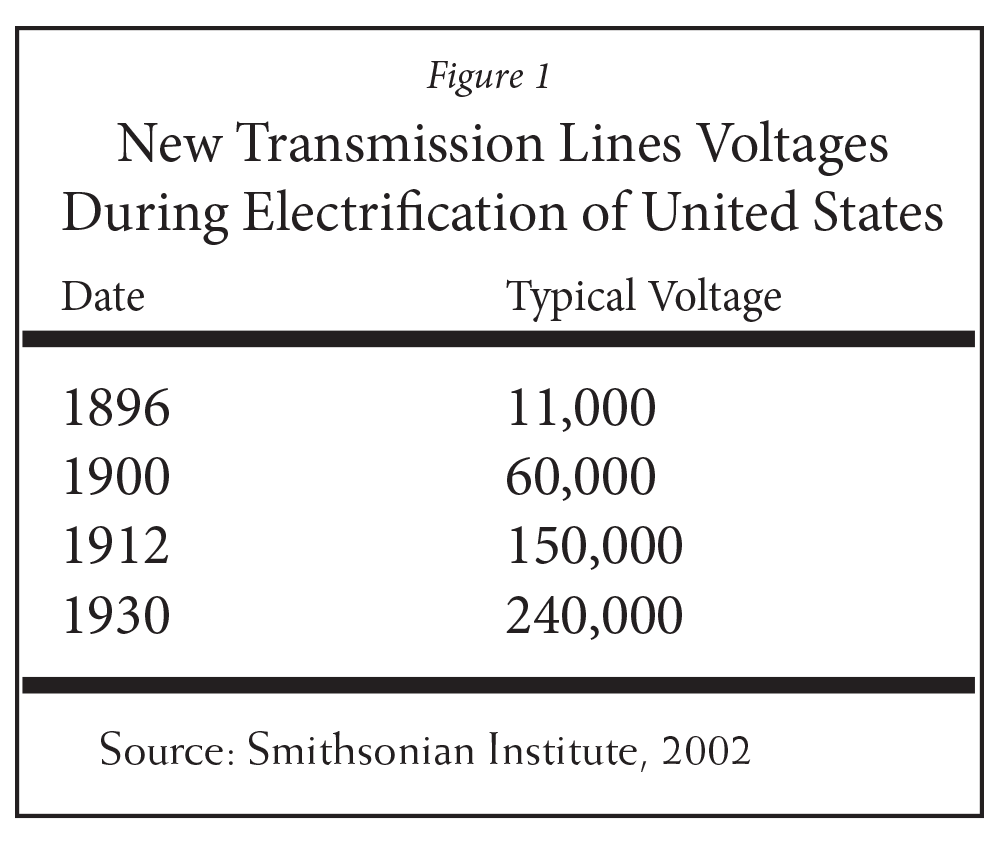
Early development of transmission was completed with very little coordination. One exception to that was the Pennsylvania-New Jersey Interconnection (PNJ). This later was replaced by PJM in 1956, and today is PJM Interconnection LLC, the first coordinated, interconnected power pool.[5] The PNJ was a 210-mile-long transmission ring that connected the electrical networks of three independent utility companies: Pennsylvania Power & Light (now known as PPL Electric Utilities or PPL), Public Service Electric and Gas Company (PSE&G), and the Philadelphia Electric Company, now known as PECO. One of the first transmission lines that became a part of the PNJ was the 230kV Roseland-Bushkill line, built between 1925 and 1931. The line ran from PSE&G’s Roseland Switching Station in Roseland, New Jersey, to PPL’s Bushkill Station in Middle Smithfield, Pennsylvania, more than 50 miles away. The PNJ agreement and transmission line was the first large-scale interconnection of its kind in North America and served as the model for the onset of the independent system operator (ISO) or regional transmission organization (RTO).
With the expansion of transmission infrastructure came federal regulation over transmission. Through the issuance of Orders Nos. 888, 889 and 2000, the Federal Energy Regulatory Commission (FERC) encouraged transmission owners to turn operational control over the transmission system to FERC-regulated ISOs and RTOs in order to maintain reliability and meet the requirement of open access, non-discriminatory transmission service. ISOs/RTOs became responsible for planning the system to ensure the reliability of the electric transmission system under its functional control and coordinating the movement of wholesale electricity within the larger interconnect. Currently more than two-thirds of the population of the U.S. and half the population of Canada obtain electricity from transmission systems operated by RTOs or ISOs. See Figure 2 for a breakdown of the ISO/RTO regions.
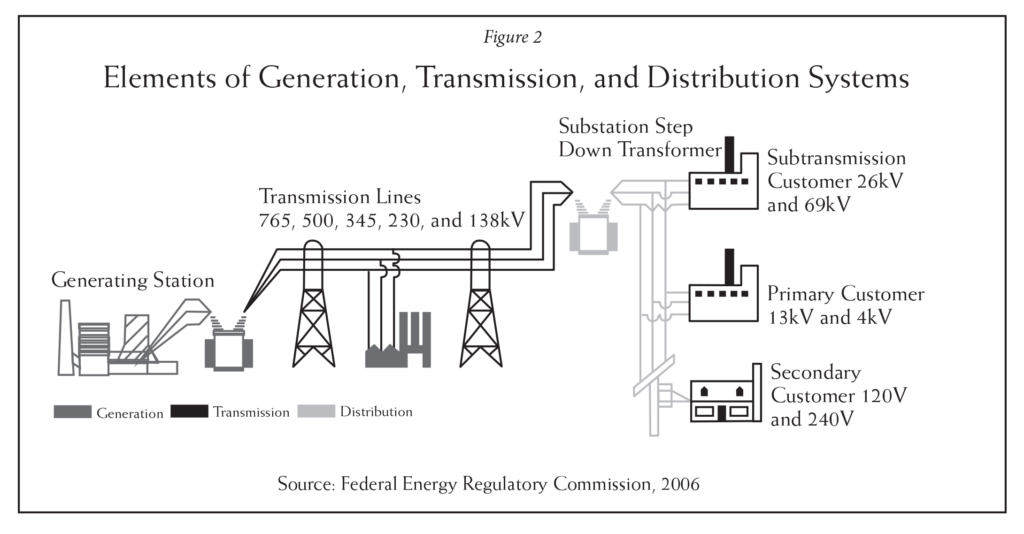
Today, the transmission system has more than 150,000 circuit miles of high voltage transmission lines which connect generating stations to utility substations. It is a highly complex system upon which the technology-dependent country has become increasingly reliant.
The Need for a Reliable and Resilient Transmission Grid
Aging Infrastructure and Increased Demand for Electricity
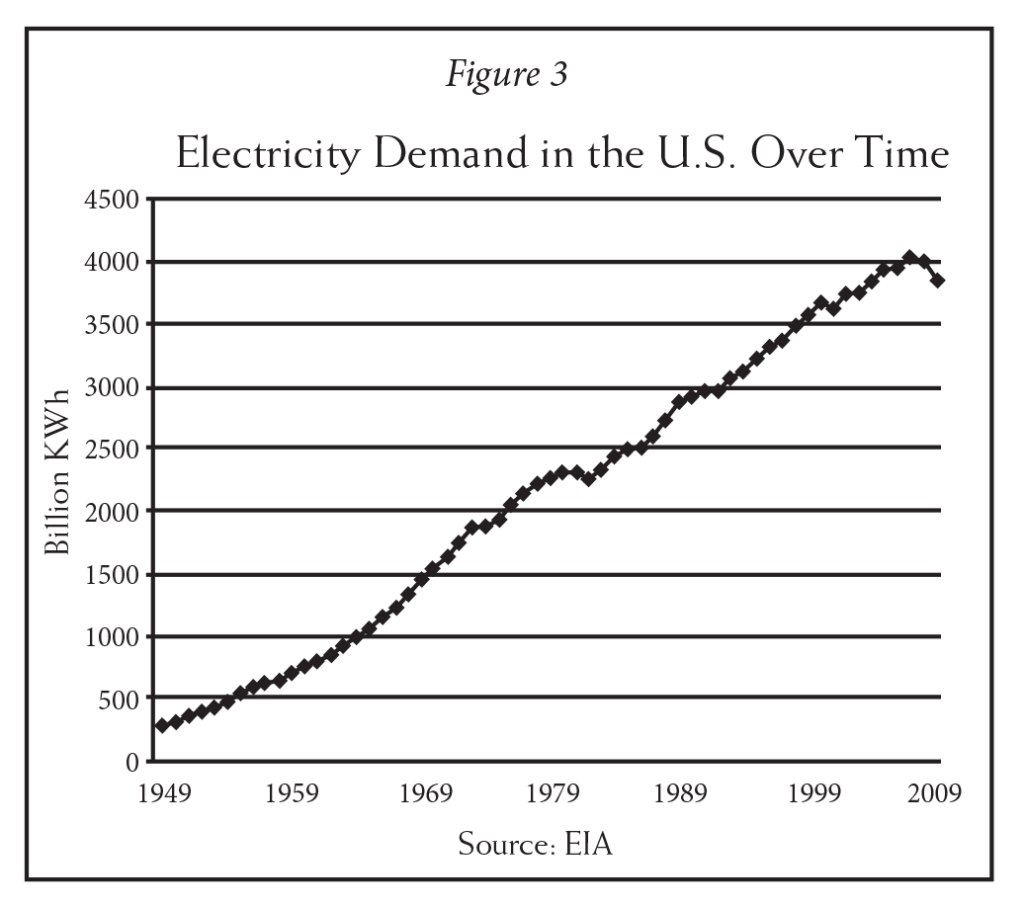
The transmission system in the U.S. is at a crossroads because of increased demand being served by a grid built mostly prior to 1950. Electricity consumption in the U.S. totaled nearly 3,826 billion kilowatt-hours (kWh) in 2012, according to the United States Energy Information Administration.[6] This is approximately 13 times greater than electricity consumption in 1950.[7] See Figure 3 for a chart showing electricity demand since 1950. Despite a recent dip owing to the recession, analysts believe that demand in the U.S. is increasing. Based on projections of the Energy Information Agency, a subset of the United States Department of Energy (DOE), electricity use is expected to increase by eight percent between 2012 and 2020 and by 29 percent from 2012 to 2040.[8] See in Figure 4.
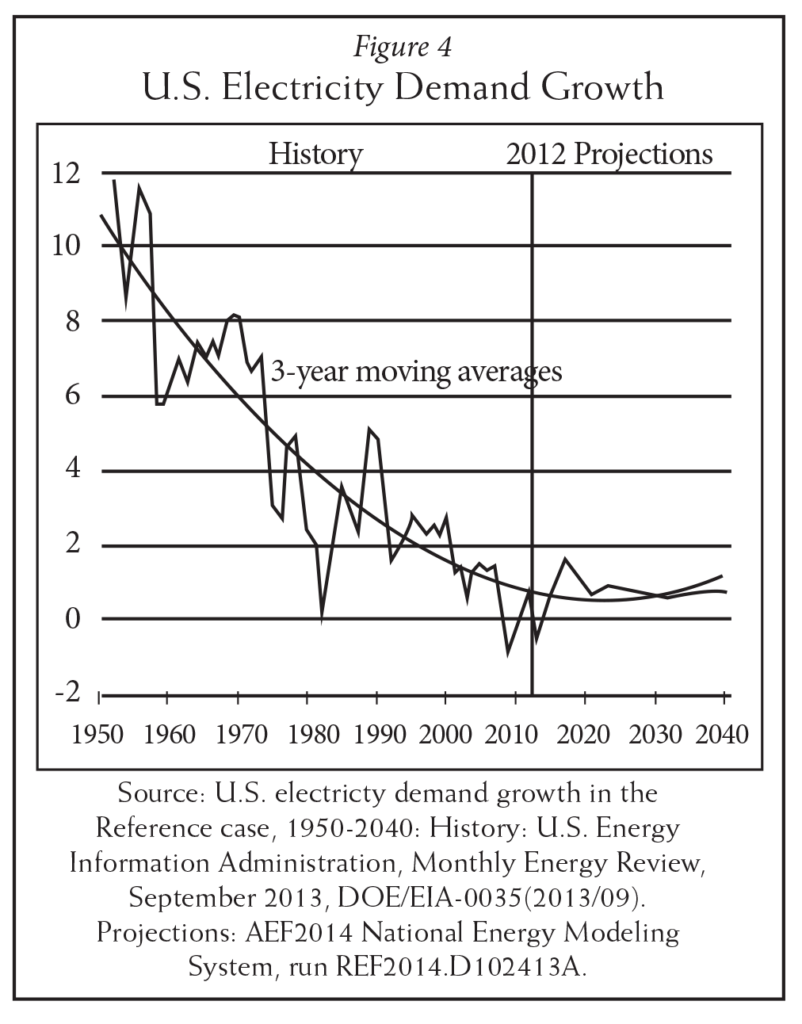
Much of the backbone of the transmission system that this country relies upon to provide electricity—138kV and 230kV lines—was built in the 1920s and 1930s. Most of these facilities are nearing the end of their useful life.
In fact, according to the DOE, 70 percent of transmission lines and transformers are 25 years or older (with an average age for transformers of 42 years), and 60 percent of the circuit breakers are 30 years or older. See Figure 5 outlining U.S. Historical Transmission Construction. The age of the grid’s components has contributed to an increase in both weather and nonweather-related power outages.[9]
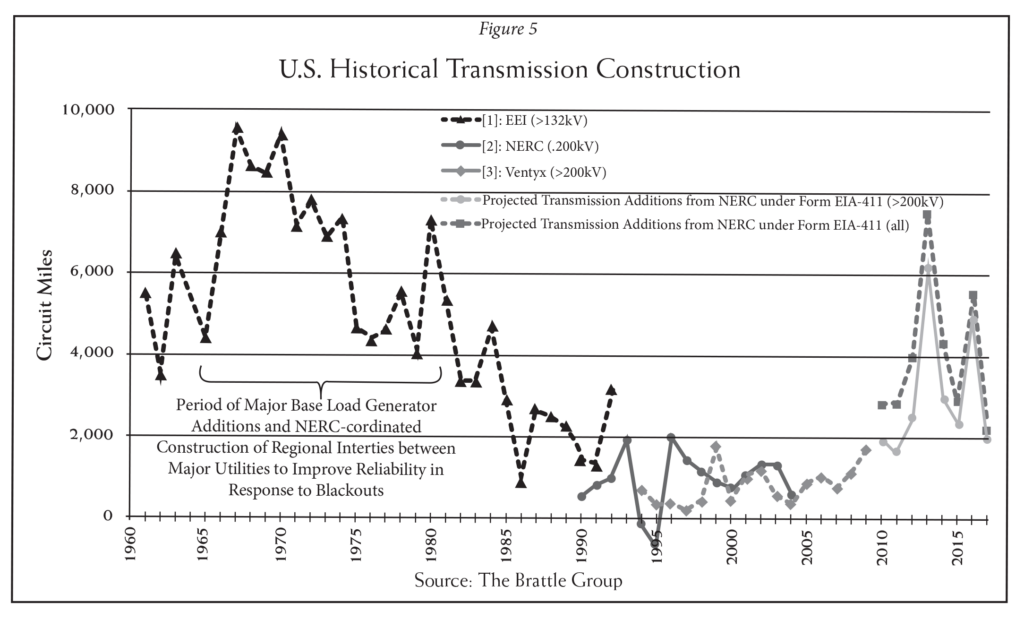
In fact, transmission investment declined by 44 percent from 1980 to 1999.[10] In response to the underinvestment and aging infrastructure, projections of the spending necessary to replace the aging transmission infrastructure vary greatly, but all agree that spending will be in the trillions. As an Edison Electric Institute Study by the Brattle Group determined, “by 2030, the electric utility industry will need to make a total infrastructure investment of $1.5 to $2.0 trillion.”[11] Recent evidence suggests transmission investment has been on the rise since 2006, but is still below rates experienced between 1960 and 1980. As evidence, in 2013, the American Society of Civil Engineers in its Report Card on American Infrastructure gave the electric industry a D+, which although was an increase from the D it gave the industry five years earlier, is not a positive sign for the industry.[12]
Economic Impact of Reliable and Resilient Service
Electricity is the lifeblood of the U.S. economy as it powers homes, businesses, offices and industries; keeps our food fresh; provides for communication and entertainment; connects people through technology and the Internet; and assists with transportation. A recent study by the Edison Electric Institute indicates that electricity intensity in the U.S. economy is significantly related to the general level of economic activity as illustrated in Figure 6.[13] But aging infrastructure, increased demand and lack of sufficient investment in transmission all lead to one outcome— increased outages. Whether in the form of lost output or wages, spoiled inventory, delayed production, increased costs on the consumer to purchase backup generators or costs incurred due to damage to the grid, experts all agree that the failure to maintain a reliable electric system can have a significant impact on the economy.
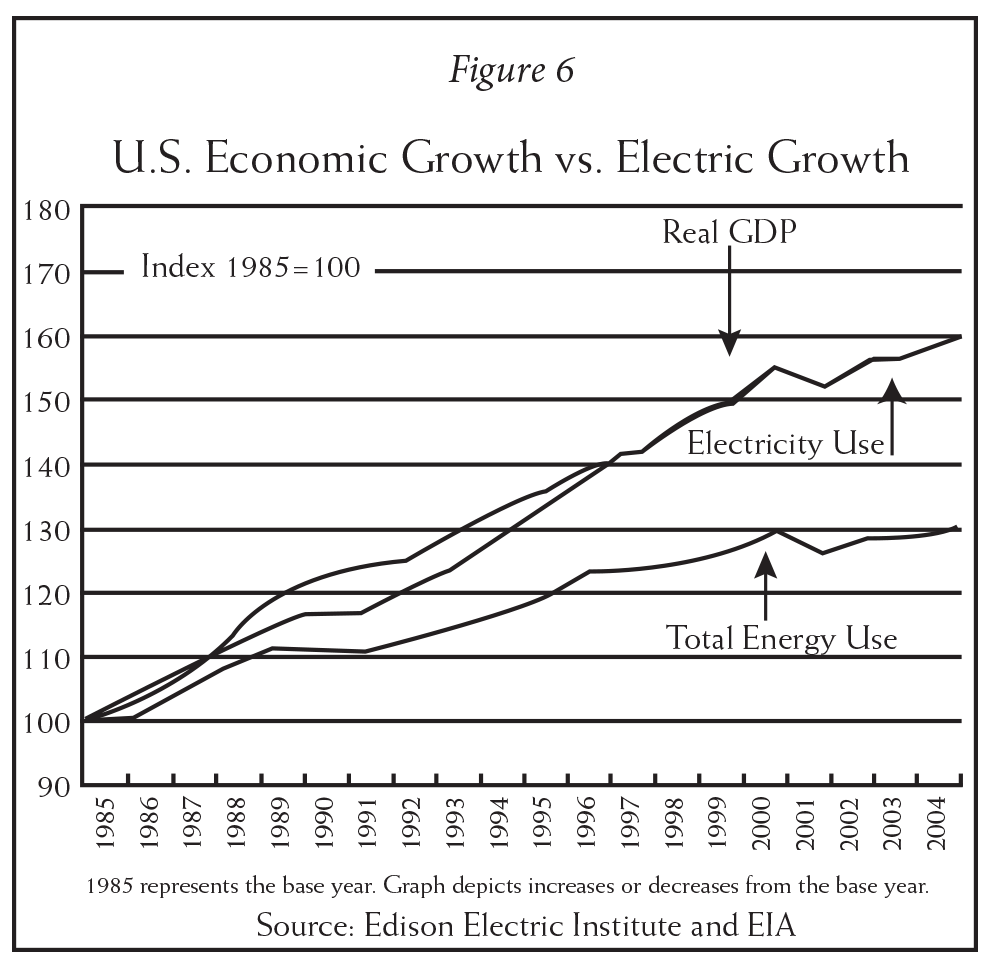

Unexpected occurrences such as weather or equipment failure, usually on the transmission system, are the main causes of outages. Since 1960, the country has endured a number of significant power outages on the transmission system. For a description, see Figure 7. In 2013, the President’s Council of Economic Advisers and the DOE’s Office of Electric Delivery and Energy Reliability prepared a report on the economic benefits of increasing electric grid resiliency. The report found that between 2003 and 2012, weather-related outages were estimated to have cost the U.S. economy an inflation-adjusted annual average of $18 billion to $33 billion. Annual costs fluctuate significantly but are highest in the years of major storms such as Hurricane Ike in 2008, a year in which cost estimates range from $40 billion to $75 billion, and Hurricane Sandy in 2012, a year in which cost estimates range from $27 billion to $52 billion.[14] Overall, between 2003 and 2012 the United States endured approximately 679 weather-related power outages, each affecting 50,000 customers.[15] And it is clear that weather-related disasters are increasing. Since 2000, billion-dollar weather-related disasters have increased significantly. See Figure 8.
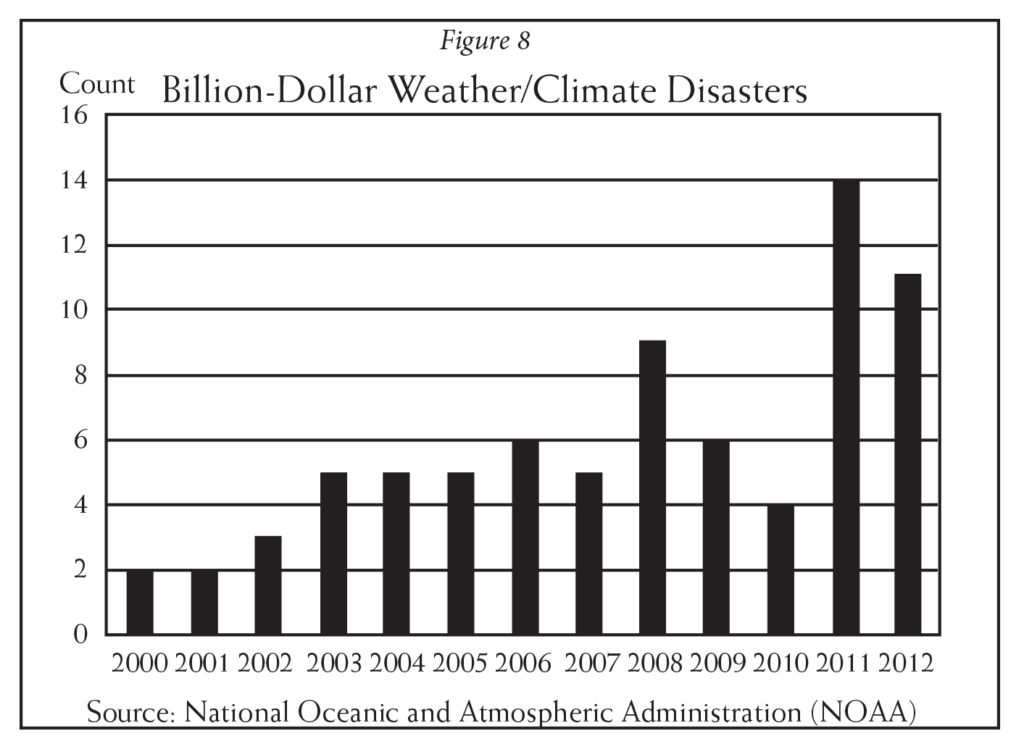
Smaller duration outages common to transmission systems are just as costly. The average cost of a one-hour power interruption has been estimated to be nearly $1,000 per business and up to $12,000 per large industrial and commercial customers.[16] A 2004 study estimated that outages of five minutes or less cost the U.S. economy nearly $50 billion annually.[17] Similarly, other studies have that number closer to $200 billion.[18] These numbers add up to a shrinking economy because of higher costs for electricity and the loss of jobs. The American Society of Civil Engineers estimates that by 2020 an unreliable electric system could cost the U.S. GDP nearly $656 billion and nearly $2.3 trillion by 2040.[19]
The good news is that ISOs and transmission owners have done an excellent job in maintaining the reliability of the electric grid given increased demand. The North American Electric Reliability Corporation (NERC) in its 2013 State of Reliability Report indicated that the “reliability of the transmission system continues to remain high.”[20] With mandatory oversight by NERC and development of new transmission lines, the outlook remains positive. Additionally, transmission owners are investing significantly in upgrades to both maintain reliability and improve the resiliency of the system to weather events. Although costs for electricity may temporarily increase because of increased investment in power plants and transmission, these capital investments will result in more stable prices in the long run. An improved electric system that maintains reliability also may reduce secondary expenditures by companies or individuals on items such as backup generators or secondary utility feeds used to mitigate the effects of outages. Ultimately, a consistently reliable and weather-resilient system is a win for the consumer with lower, stable electric bills and additional money to spend in the economy.
Obstacles Facing Construction of New Transmission
Although there is ample evidence of the need for additional transmission infrastructure, actually designing, permitting and constructing transmission is a time-consuming, complex and expensive process. Signifi cant obstacles to construction include siting, environmental permits, property acquisition, financing, and “not in my back yard” (NIMBY) complaints. While permitting times for major transmission vary by state, the average time for permitting has risen to approximately three years and longer. The Wyoming-Jacksons Ferry line between Virginia and West Virginia, which required approval from the U.S. Forest Service and the states involved, spent 13 years in the permitting phase.[21] These delays ultimately jeopardize construction and impact reliability.
Currently, unlike gas transmission facilities, there is no federal siting authority for transmission facilities. The Energy Policy Act of 2005 had included a federal backstop authority for projects that were not approved by a state siting authority within 12 months of application submittal, but that authority was limited to areas designated as a National Interest Electric Transmission Corridor. Although the DOE did originally designate a number of National Interest Electric Transmission Corridors, those designations were overturned by the United States Ninth Circuit Court of Appeals.[22] Therefore a new transmission line typically requires siting approval from the states within which the line crosses, environmental permits from either the state environmental agency or the United States Environmental Protection Agency, and may include permits from special governmental areas such as national parks and wildlife preservation areas. In addition, a new line may require the acquisition of real estate rights necessary for new rights-of-way, which could trigger extensive eminent domain proceedings.
In 2008, PSE&G and PPL Electric Utilities began the process of siting a PJM-mandated upgrade to the existing 230kV Roseland-Bushkill Transmission Line which, as noted above, was originally part of the historic Pennsylvania-New Jersey Interconnection. The upgrade called for the installation of a new 500kV line from PSE&G’s Roseland Switching Station in Roseland, New Jersey, through Bushkill, Pennsylvania, and north to PPL’s Susquehanna Generating Station on the existing transmission right-of-way that was created for the Roseland-Bushkill line. The proposed 500kV line was in addition to, and not a replacement of, the existing 230kV line. While PSE&G was responsible for the permitting on the New Jersey side, PPL took that responsibility on the Pennsylvania side.
The proposed Susquehanna-Roseland 500kV Project (the Project) required siting approval from both the New Jersey Board of Public Utilities and the Pennsylvania Public Utility Commission. In addition, on the New Jersey side alone, wetland and flood hazard permits were required from the New Jersey Department of Environmental Protection, Army Corps of Engineers approval was required for crossings of major waterways, and significant property acquisition was required for two new switching stations, temporary construction access, storage and lay down areas, helicopter fl y yards (since a number of towers were constructed with air cranes in order to avoid impacting sensitive environmental areas) and some minor expansions of the existing right-of-way.
The Project had to overcome many obstacles. While permitting at the state public utility commissions took approximately a year to complete, the Project spanned the Delaware Water Gap National Recreation Area and the Appalachian National Scenic Trail, which is governed by the National Park Service, a part of the Department of the Interior. Even though the existing right-of-way (and thus the existing Roseland-Bushkill 230kV line) pre-dated the Delaware National Recreation Area, the Project required a special use permit from the National Park Service. Since the issuance of a special use permit is a federal action, it triggered a mandatory review under the National Environmental Policy Act. The National Park Service prepared an Environmental Impact Statement and ultimately found no adverse impacts, but the process took approximately four years and delayed the Project in-service date by two years.
This type of federal review is not uncommon given the nature of interstate transmission lines, especially in the western U.S. where approximately 53 percent of land is federally owned. A recent study by NERC has indicated that a majority of transmission projects were experiencing delays of up to three years and that nearly 6,500 transmission construction projects were considered delayed by RTOs as of the end of 2009.[23] The National Electrical Manufacturers Association has prepared a flow chart outlining many of the different federal permits that may be required and how those permits can delay a proposed transmission project.24 However, these delays can be shortened as the federal government has pledged to move these types of projects through the permitting process more effectively. For example, the interagency Rapid Response Team for Transmission was created to improve the time necessary to obtain federal approvals. The Susquehanna-Roseland Project was one of the first transmission projects to benefit from this process.
Nevertheless, the Susquehanna-Roseland Project also faced significant NIMBY challenges that are similar to obstacles faced by most large transmission projects. A grass roots group of residents in New Jersey calling themselves Stop-the-Lines opposed the Project and raised issues ranging from property values and health effects from electromagnetic fields (EMF) to the impact of the Project on residents’ ability to obtain an FHA mortgage. Additionally, environmental groups raised concerns regarding the impact that construction access roads would have on environmentally sensitive areas. Although these emotionally charged issues typically make for a good sound bite, they are becoming easier to deal with as the issues are thoroughly studied and new technology is implemented.
For example, two literature reviews recently were completed on the effects of electric transmission lines on property values. These reviews studied all of the analysis completed during the past 30 years. The results showed that electric transmission lines have very little if any effect on neighboring property values, especially within existing rights-of-way.[25]
Likewise, after nearly 40 years of studying the health effects of EMF, the conclusions reached by national and international scientific and health agencies and the guidelines for exposure they have recommended make clear that exposures to EMF that people encounter in their daily lives, including those from transmission lines, do not pose any recognized long-term health risks.[26] However, despite these conclusions, these same agencies recommend the use of a policy called “Prudent Avoidance.”
Prudent Avoidance is a precautionary principle in risk management, stating that reasonable efforts to minimize potential risks should be taken when the actual magnitude of the risks is imprecise. A report for the Office of Technology Assessment of the U.S. Congress described prudent avoidance of power line fields as:
… looking systematically for strategies which can keep people out of 60 Hz fi elds arising from all sources but only adopt those which look to be ‘prudent’ investments given their cost and our current level of scientific understanding about possible risks.[27]
Similarly, the World Health Organization recommends in a recent fact sheet: “When constructing new facilities … low-cost ways of reducing exposures may be explored. Appropriate exposure reduction measures will vary from one country to another. However, policies based on the adoption of arbitrary low exposure limits are not warranted.”[28] Such reduction measures typically include implementing low field designs. For example, bringing the lines closer together, increased tower heights, increased right-of-way width or phase splitting (assigning multiple conductors per phase) are low-cost options to mitigate EMF exposure. These measures along with the reports of the scientific community have reduced the effectiveness of EMF complaints by opponents to transmission construction.
Similarly, property acquisition also can be a challenge to transmission construction, especially in densely populated areas like the Northeast where commercial and residential development has encroached upon existing transmission lines. For the New Jersey portion of the SusquehannaRoseland Project, it was nearly impossible to increase the width of the existing 150-wide right-of-way or change the route because of significant development constructed immediately adjacent to the right-of-way since it was established in 1928. In these cases, utilities can either consider underground construction or build higher towers.
Underground construction, although exhorted by the NIMBY crowd, comes with its own challenges and complications. The cost of underground transmission lines has been estimated to be anywhere from five to 20 times as expensive as overhead lines, and those costs are passed to customers. While underground lines are less prone to weather events, the time to repair such an outage is measured in days, weeks and in some cases, months as compared to hours or days to repair an overhead line. This is because faults are harder to locate and more difficult to repair. Underground transmission lines also may require large transition stations to convert the transmission line from underground to overhead.
Although rights-of-way can be smaller with an underground installation (20–50 feet wide for a typical underground right-of-way to 75–200 feet wide for a typical overhead right-of-way [29]) the impacts to the environment are greater. Typically, for overhead construction, a tower is placed every 600–1,000 feet, and one or more foundations are required that may be several feet in diameter. At a minimum, underground construction requires a continuous trench at least five feet in width and a significant access road immediately adjacent to the trenched area. The road is necessary to carry heavy loads such as large excavation equipment, concrete trucks, tractor-trailers with 80,000-lb. manholes and 50,000-lb. cable reels. This type of construction would have a permanent effect on the environment and would be difficult to permit given the nature of environmental regulations.
Given these issues, overhead construction is still, and will be, the main type of construction for years to come. As of 2006, less than one percent of 230kV lines were underground in the U.S. and that number drops to 0.5 percent for 345kV and to near zero percent for 500kV lines and higher.30 However, with implementation of new technologies, the decrease in the cost of underground construction and the limited availability of land to construct overhead lines, the number of underground lines going forward will likely increase. In fact, the Edison Electric Institute’s 2012 analysis has indicated that the percent of underground transmission has been rising since 2006 to a high of 15 percent of total transmission investment in 2008.[31]
Conclusion
Despite all of the hurdles, transmission construction is being completed. For example, the Susquehanna-Roseland Project is nearly complete as half of the project was energized on April 1, 2014, with the other half planned to be completed by June 2015. PSE&G has also recently completed construction and energized two intrastate 230kV upgrade projects within the past year and is currently permitting two other projects. In addition, the Trans-Alleghany Interstate 500kV Line connecting Pennsylvania, West Virginia and Virginia consisting of 661 towers was energized in May of 2011; and the 55- mile, 345kV Alexandria-Waite Park portion of the Fargo to St. Cloud Project was completed in 2014. As reported in FERC’s Energy Infrastructure Update, transmission construction has been and continues to rise.[32]
The federal government also has identified that transmission infrastructure is needed for reliability and resiliency and has provided help. The Energy Policy Act of 2005 has authorized FERC to offer transmission providers incentives to promote new transmission. Federal agencies have begun to acknowledge the difficulties of permitting by federal and state agencies, and efforts such as the rapid response team and a discussion on one-stop siting will help address major challenges to the siting of transmission. Given the age of the current system and the country’s reliance on the transmission grid, investing in a new, reliable and resilient transmission grid will be vital not only to keep the lights on, but to maintain a strong, growing economy. ■
Endnotes
1. “Failure Reveals Creaky System, Energy Experts Believe,” The New York Times, Aug. 15, 2003.
2. “Ten Year Outlook for Electric Reliability Highlights | Environmental Initiatives, Transmission among Key Concerns,” North American Electric Reliability Corporation, Oct. 23, 2008, http:www.nerc.com/news_pr.php?npr=186.
3. Brown, Matthew H. and Richard P. Sedano, Electricity Transmission, A Primer, National Council on Electricity Policy, June 2004, p. 2.
4. Ibid., p. 4.
5. http://www.pjm.com/~/media/Images/ctc-display/modules/ timeline/1970-pjm-relocates-background-information.ashx.
6. http://www.eia.gov/forecasts/aeo/MT_electric.cfm#cap_ natgas?src=Electricity-b1.
7. Ibid.
8. Ibid.
9. “Economic Benefits of Increasing Electric Grid Resilience to Weather Outages,” Executive Office of the President, August 2013.
10. “Transmission & Distribution Infrastructure,” Harris Williams & Co. white paper, Summer 2010, p. 4.
11. Chupka, Marc W. et al., “Transforming America’s Power Industry: The Investment Challenge 2010-2030,” The Brattle Group, 2008, p. 2.
12. “2013 Report Card for American Infrastructure,” American Society of Civil Engineers, 2013. www.infrastructurereportcard.org.
13. “Rising Electricity Costs: A Challenge for Consumers, Regulators, And Utilities,” Edison Electric Institute, May 2006.
14. “Economic Benefits of Increasing Electric Grid Resilience to Weather Outages,” Executive Office of the President, August 2013.
15. Ibid.
16. “Failure to Act: The Economic Impact of Current Investment Trends in Electricity Infrastructure,” American Society of Civil Engineers, 2013.
17. Ibid.
18. Op. cit. at 14, p. 17.
19. Op. cit. at p. 16.
20. “2013 State of Reliability Report,” North American Electric Reliability Corporation, May 2013.
21. “State Strategies for Accelerating Transmission Development for Renewable Energy,” National Governors Association Issue Brief, p. 12, http://www.nga.org/files/live/sites/ NGA/files/pdf/1201ENERGYTRANSMISSIONBRIEF.PDF.
22. California Wilderness v. U.S. Department of Energy, 631 F.3d 1072 (9th Cir. 2011).
23. Op. cit. at p. 21.
24. http://www.nema.org/Policy/Documents/tc-gameboard-4web.pdf.
25. Jackson, Thomas O. and Jennifer Pitts, “The Effects of Electric Transmission Lines on Property Values, A Literature Review, Mays Business School, Texas A&M University, 2010; “Transmission Lines & Property Value Impacts,” Headwaters Economics, prepared for the MSTI Review Project, May 2012, www.headwaterseconomics.org.
26. http://www.who.int/peh-emf/about/WhatisEMF/en/index1.html.
27. “Biological Effects of Power Frequency Electric and Magnetic Fields,” Office of Technology Assessment background paper, OTA-BP-E-53, U.S. Government Printing Office, Washington, D.C., May 1989.
28. www.who.int/mediacentre/factsheets/fs322/en/index.html.
29. Wise, Kristi and Cyril Welter, “Going Underground, A Growing Reality for Transmission Routing,” Burns & McDonnell, 2003.
30. “Overhead v. Underground, Information about Undergrounding High-Voltage Transmission Lines,” Xcel Energy Inc., 2011, https://www.xcelenergy.com/staticfiles/xe/Regulatory/Transmission/ OverheadvsUnderground.pdf.
31. Hall, Kenneth L., “Out of Sight, Out of Mind, 2012, An Updated Study on the Undergrounding of Overhead Power Lines,” prepared for Edison Electric Institute, January 2013.
32. http://www.ferc.gov/legal/staff -reports/2014/apr-infrastructure.pdf.






